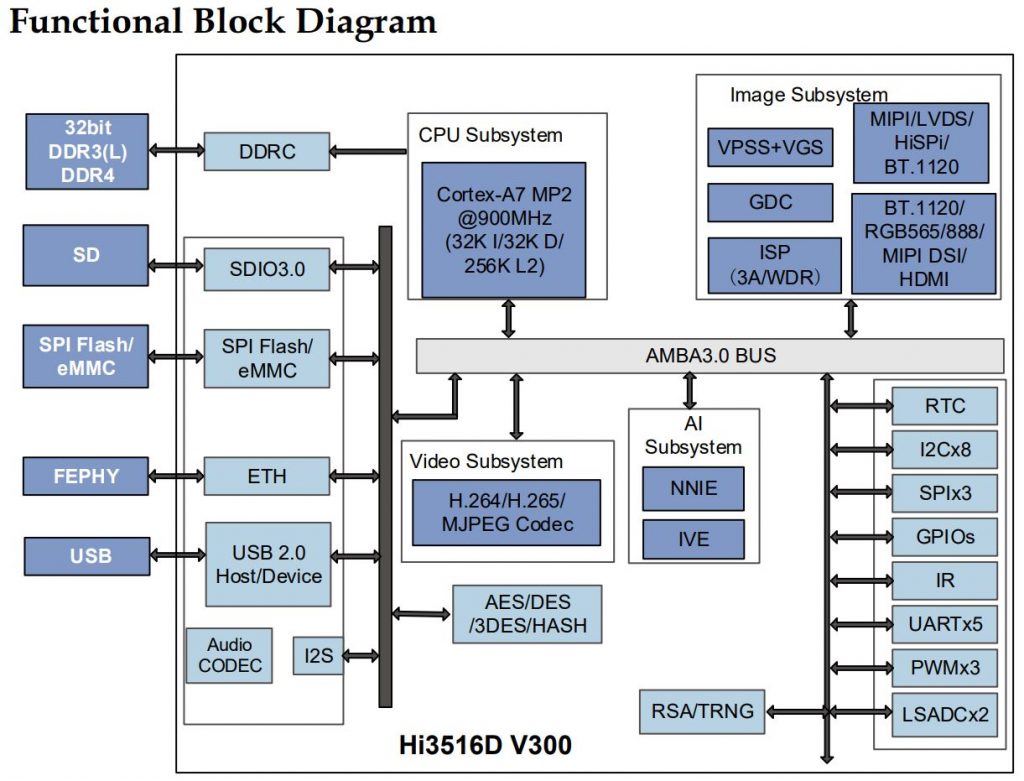海思Hi3516D V300芯片简介, 专业智能摄像头SoC
Hi3516D V300 Professional Smart IP Camera SoC
Hi3516D V300 is a new-generation SoC designed for the industry-dedicated smart HD IP camera. It introduces a new-generation ISP, the latest H.265 video compression encoder, and a high-performance NNIE engine, enabling Hi3516D V300 to lead the industry in terms of low bit rate, high image quality, intelligent processing and analysis, and low power consumption. Integrated with the POR, RTC, audio codec, and standby wakeup circuit, Hi3516D V300 can greatly reduce the EBOM costs for customers. Hi3516D V300 also provides similar interface designs to the HiSilicon DVR and NVR SoCs, facilitating rapid mass production.

Key Specifications
Processor Core
Dual-core ARM Cortex-A7@ 900 MHz, 32 KB I-cache,32 KB D-cache, 256 KB L2 cache
Neon acceleration and integrated FPU
VEDU
H.264 BP/MP/HP
H.265 MP
I-/P-frames and SmartP reference.
MJPEG/JPEG baseline
VEDU Performance
Up to 2688-pixel wide and 2688 x 1944 resolution for H.264/H.265 encoding and decoding. Only the decoding of self-encoded streams is supported.
Real-time multi-stream H.264/H.265 encoding and
decoding:
− 2688 x 1536@30 fps encoding +720 x 480@30 fps encoding + 360 x 240@30 fps encoding
− 2688 x 1944@20 fps encoding +720 x 480@20 fps encoding + 360 x 240@20 fps encoding
− 1920 x 1080@30 fps encoding + 720 x 480@30 fps encoding + 1920 x 1080@30 fps decoding
JPGE encoding and decoding performance: 16M (4608 x
3456) @10 fps
Five bit rate control modes (CBR, VBR, FixQp, AVBR,
and QpMap)
Up to 50 Mbit/s output bit rate
Up to 8-ROI encoding
Smart Video Analysis
Neural network acceleration engine(NPU) with processing performance up to 1.0 TOPS
Smart computing acceleration engine (including tracking and face image correction)
Video and Graphics Processing
3DNR, image enhancement, and DCI
Anti-flicker processing for video and graphics output 1/15–16x video and graphics scaling
Video graphics overlay 90°, 180°, and 270° image rotation
Image mirroring and flipping
Up to 8-region OSD overlay before encoding
ISP
3A functions (AE, AF, and AWB), supporting third-party
3A algorithms
FPN removal and DPC
LSC, LDC, and purple fringing correction
Direction-adaptive demosaic
Gamma correction, DCI, and color management and enhancement
Region-adaptive dehaze
Multi-level NR (including BayerNR and 3DNR), detail enhancement, and sharpening enhancement
Local tone mapping
Sensor built-in WDR and 2F WDR (line-based/framebased/DCG)
Video-/Gyro-based 6-DoF IS
ISP tuning tools for the PC
Audio Encoding and Decoding
Multi-protocol audio encoding and decoding (G.711,G.726, and ADPCM) by using software Audio 3A functions (AEC, ANR, and ALC)
Security
Secure boot
Hardware-based memory isolation
Hardware-based encryption and decryption algorithms(including AES, DES, 3DES, and RSA)
Hardware-based HASH algorithms(SHA1/SHA256/HMAC_SHA/HMAC_SHA256)
Hardware random number generator
8-kbit OTP storage space
Video Interface
VI
− 2-channel VI
Up to 2688-pixel wide and 2688 x 1944 resolution for input of the first channel
Up to 2048-pixel wide and 2048 x 1536 resolution for input of the second channel
− 8-/10-/12-/14-bit RGB Bayer DC timing VI
− BT.601, BT.656, and BT.1120 VI interfaces
− MIPI, LVDS/sub-LVDS, and HiSPi
− Compatibility with mainstream HD CMOS sensorsprovided by vendors such as Sony, ON, OmniVision,and Panasonic
− Compatibility with the electrical specifications ofparallel and differential interfaces of various sensors
− Programmable sensor clock output
VO
− One BT.656/BT.1120 VO interface
− 6-/8-bit RGB serial LCD VO and 16-/18-/24-bit RGB parallel LCD VO
− 4-lane MIPI-DSI VO
− HDMI 1.4 output with a maximum resolution of 1080p60
Audio Interface
Audio codec, supporting 16-bit input and output
Mono-channel differential MIC input for background NR
Single-end dual-channel input
I2S interface for connecting to external audio codec
Peripheral Interface
POR
High-precision RTC
2-channel LSADC
I2C interfaces, SPIs, and UART interfaces
Three PWM interfaces
Two SDIO 3.0 interfaces, supporting the 3.3 V/1.8 V level
− SD 3.0 card supported over one SDIO 3.0 interface One USB 2.0 host/device interface RMII mode, TSO network acceleration, 10/100 Mbit/s full-duplex or half-duplex mode, and PHY clock output
External Memory Interface
SDRAM interface
− 32-bit DDR3(L)/DDR4 SDRAM, supporting a maximum capacity of 16 Gbits
− Up to 1800 Mbit/s rate SPI NOR flash interface
− 1-/2-/4-line mode
− Maximum capacity of 256 MB SPI NAND flash interface
− Up to 24 bit/1 KB ECC performance
− Maximum capacity of 1 GB
eMMC 4.5 interface
4-bit data width
Startup
Booting from the SPI NOR flash, SPI NAND flash, or eMMC
SDK
Linux-4.9-based SDK
High-performance H.264 PC decoding library
High-performance H.265 PC, Android, and iOS decoding
libraries
Physical Specifications
Power consumption
Typical power consumption at 4M (2688 x 1536)P30 fps:
TBD
Operating voltage
− 0.9 V core voltage
− 3.3 V I/O voltage (±10%)
− 1.5 (1.35) V/1.2 V DDR3(L)/4 SDRAM interface
voltage
Package











